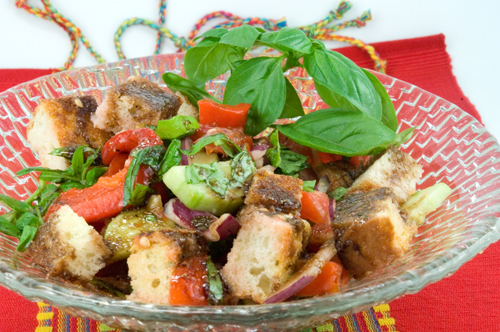
Waning days of summer. And it’s still hot out there in some parts. We’re still hooked on salads. And that’s where pasta salads come in. Contrary to popular opinion, pasta salads are not traditionally Italian. They’re an American innovation, just like Pasta Primavera; although they’ve become a part of the Italian repertoire. What makes pasta salads great is that they can be prepared in advance. They’re great for outings and picnics. They make good party food; and you can feed lots of people for minimal expense.
Any pasta type or shape can be used for these salads. My favorite has always been soba buckwheat noodles, cooked, drained, and tossed with toasted sesame seeds, a little soy sauce, scallions, and dash of sesame oil. This gives an Oriental twist; and it can be served hot or cold. But the two recipes included today are more traditional pasta salads. One is a simple salad perfect for summer: just red tomatoes, mozzarella, basil, parsley and a plain vinaigrette of olive oil and vinegar. The second recipe includes cooked chicken or turkey along with other veggies and white beans.
The fun with pasta salads is that you can experiment and use whatever combination fits, even adding seafood such as canned tuna or any other type of cooked fish, even mussels. You are only limited by your imagination. The one thing to remember is never to soak the cooked pasta in cold water. This makes the pasta soggy, and you don’t want that. Simply cook the pasta al dente (to the tooth), and drain it thoroughly. Just toss the pasta with whatever dressing desired. However, if you’re using mayonnaise, it’s best to wait until the pasta has cooled before adding the mayo, or the mayonnaise may spoil. Other that that, go at it.
SIMPLE PASTA SALAD
1/2 cup olive oil, preferably extra virgin
1 tablespoon red wine vinegar
Salt and ground black pepper to state
1 teaspoon dried oregano
3 cups cooked penne or any other tube or shell-like pasta
3 ripe tomatoes, washed and diced
5 ounces mozzarella, diced
10 pitted black olives, sliced in half
1/2 cup fresh basil, rinsed and chopped
1/4 cup fresh Italian parsley, rinsed and chopped
1. In a small jar or cruet, whisk together the olive oil and vinegar, salt, pepper, and oregano
2. In a large bowl, mix together the pasta, tomatoes, mozzarella, olives,basil and parsley.
3. Add the dressing and toss to combine.
Yield: 4 servings.
PASTA SALAD WITH CHICKEN OR TURKEY
1/2 cup olive oil, preferably extra virgin
2 clove garlic, peeled and finely minced
1 teaspoon dried oregano
Salt and ground black pepper to taste
2 cups cooked, diced chicken breast or turkey
3 ripe tomatoes, washed and diced
1/4 cup pitted black olives, sliced in half
1 16-ounce can cannellini beans, drained
1/2 cup fresh basil, rinsed and chopped
1 green bell pepper, washed and chopped
3 cups cooked bow-tie pasta, or any tube or shell-like pasta
1 cup mixed salad greens of your choice.
1. In a jar or cruet, whisk olive oil, garlic, oregano, salt and pepper.
2. In a large bowl, mix together the chicken or turkey, tomatoes, olives, beans, basil, and bell pepper.
3. Stir in the pasta. Add the dressing and toss to combine.
4, Stir in the salad greens, and serve.
Yield: 4-6 servings.
photo: courtesy of ifood.tv











